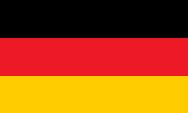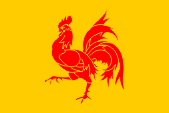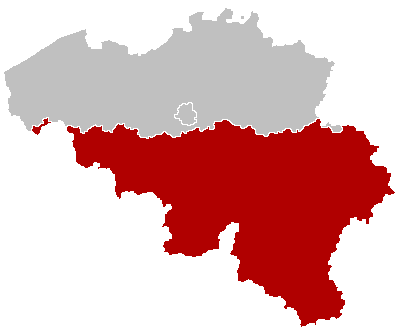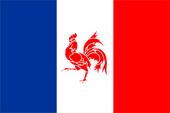mobile View, to the German Version tap the flag


- autonomous Region in Belgium
- own names: French: Wallonie, Wallonian: Waloneye, Flemish: Waal, German: Wallonien
• Flag
• Meaning/Origin of the Flag
• Map
• Numbers and Facts
• History
• Origin of the Country's Name
• German-speaking Community
• Parti Rattachiste France

Flag of Wallonia,
ratio = 2:3,
Source, by: Flags of the World






The cock is the "Gallic Rooster". Behind this is a pun: in Latin means cock "Gallus" . The same word was also used for the "Gauls". The French speaking Romans see themselves as descendants of the Gauls, and thus the cock presented itself as a symbol and it became used as a national symbol since the time of the Renaissance. In Wallonia, the red cock on gold was introduced in 1913, but not officially. Only in 1975, he was also officially used, and officially adoped on 15th of July in 1998.
Source: Wikipedia (EN),
Flags of the World


Position in Belgium:

Source: LennartBolks, Public domain, via Wikimedia Commons

Area: 6.503 square miles
Inhabitants: 3.633.795 (2019), mostly Walloons, further Flemings and Germans
Density of Population: 559 inh./sq.mi.
Capital: Namur (Flemish: Namen), 110.779 inh. (2019)
official Languagen: French (Wallonian), regional German
Currency: 1 Euro (EUR, €) = 100 Cents
Time Zone: GMT + 1 h
Source: Wikipedia (D)

58–51 B.C. · Roman conquest
481–843 · to the Frankonian Empire
880 · in the duchy Lorraine to the East Frankonian Empire (German Empire), Flandern remains at the Frankonian Empire
12th till 14th cent. · as small states within the German Empire
1384 · by marriage to the Duchy of Burgundy and in this way to the German Empire
1555 · the House of Habsburg inherits Burgundy
1714 · the Habsburg possessions come to the Austrian lineage of the House of Habsburg
1795 · conquest and annexation by France
1815–1830 · to the United Netherlands
1830 · creation of Belgium with the aim of a French speaking state to be, Wallonia becomes annexed to Belgium
about 1840 · foundation of the "Flemish movement" to preserve the language and Flemish culture
about 1880 · foundation of the "Walloon movement" as an adversary
1898 · "Equality Act", Belgium is officially a bilingual country
1962–1963 · definition of the linguistic border between the cultural communities, Brussels is bilingual, recognition of the German language as a regional language in Eastern Belgium
1970 · first Belgian state reform, the cultural communities become an constitutional rank
1980 · second Belgian state reform, creation of the Walloon Region with status of autonomy
1983 · establish of the German Community in Eastern Belgium as part of Wallonia
1988 · third Belgian state reform, expansion of regional autonomy, creation of the Region Brussels-Capital
1994 · fourth Belgian state reform, division of the former province of Brabant, further strengthening of the autonomy of regions, Belgium becomes a federal state
2001 · fifth Belgian state reform, further strengthening of the autonomy of the regions
Source: Atlas zur Geschichte,
Wikipedia (D)

The name "Wallonia", or even the word "Walloon" for the French-speaking Belgians go back to the Germanic word "welsch", what means "foreign". So was called all that, what was not-Germanic. The Walloons speak Walloon colloquially today, which is usually regarded as a French dialect, but sometimes even as a separate Romanesque language. However, official language is French.
Source:
Handbuch der geographischen Namen,
Wikipedia (D)

more Info → click here

Flag of the German-speaking Community in Belgium
ratio = 1:1,
Source, by: Wikipedia (EN)




That political movement seeks the secession of Wallonia from Belgium and its annexation to France.

Flag of the movement,
ratio = 2:3,
Source, by: Flags of the World





![]()













